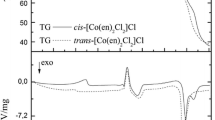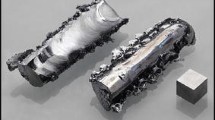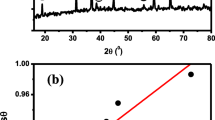Abstract
Prussian blue analogues with formulae Ni3[Co(CN)6]2·16H2O(I), Cu3[Co(CN)6]2·17H2O(II), Ni3[Fe(CN)6]2·15H2O(III) and Cu3[Fe(CN)6]2·13H2O(IV) have been synthesized. The thermal decomposition of all complexes in oxidizing (air), reducing (hydrogen) and inert (argon) atmospheres was studied in the temperature range from 20 to 1000 °C. TG–DSC curves were obtained; analysis of solid thermolysis products was performed. It was established that the decomposition process of all the studied compounds in air ends up to 450–500 °C, and mass loss continues up to 1000 °C in argon. Solid products of thermolysis are oxides of central ions (NiO, CuO, Co3O4, Fe3O4) in air; mixtures of metals or Ni3Fe (III) in argon; Ni and Co (I) and Ni3Fe + Fe(III), and mixtures of Cu + Co (II) and Cu + Fe(IV) in hydrogen. Hexacyanocobaltates are reduced at lower temperatures and more fully than hexacyanoferrates under the same conditions.




Similar content being viewed by others
Notes
The inflection points of the TG curves corresponding to the transition from one process stage to the next.
During thermolysis in hydrogen only.
This BCC was used for comparison, since we were not able to synthesize the corresponding copper-containing BCC [Cu(NH3)4]3[Fe(CN)6]2.
References
Pechenyuk SI, Domonov DP, Gosteva AN, Semushina YP, Shimkin AA. Thermal behavior of double complexes [Co(NH3)6][Fe(CN)6] and [Co(en)3][Fe(CN)6]·2H2O. Russ J Chem Chem Technol. 2018;61:49–56 (in Russian).
Domonov DP, Pechenyuk SI. Thermal behavior features of double complex [Ni(NH3)6]3[Fe(CN)6]2. Bull South Ural State Univ Ser Chem. 2016;8(4):52–60 (in Russian).
Krap CP, Balmaseda J, Zamora B, Reguera E. Hydrogen storage in the iron series of porous Prussian blue analogues. Int J Hydrogen Energy. 2010;35:10381–6. https://doi.org/10.1016/j.ijhydene.2010.07.109.
Al-Hajjaj AA, Zamora B, Bavykin DV, Shah AA, Walsh FC, Reguera E. Sorption of hydrogen onto titanate nanotubes decorated with a nanostructured Cd3[Fe(CN)6]2 Prussian Blue analogue. Int J Hydrogen Energy. 2012;37:318–26. https://doi.org/10.1016/j.ijhydene.2011.09.094.
Newton GN, Nihei M, Oshio H. Cianide-bridged molecular squares—the building units of prussian blue. Eur J Inorg Chem. 2011;20:3031–42. https://doi.org/10.1002/ejic.201100407.
Ng CW, Ding J, Shi Y, Gan LM. Structure and magnetic properties of copper(II) hexacyanoferrate(III) compounds. J Phys Chem Solids. 2001;62:767–75. https://doi.org/10.1016/S0022-3697(00)00248-1.
Ng CW, Ding J, Wang L, Gan LM, Quek CH. Thermal-induced microstructural changes of nickel-iron cyanide. J Phys Chem A. 2000;104:8814–22. https://doi.org/10.1021/jp000881w.
Ng CW, Ding J, Gan LM. Microstructural changes induced by thermal treatment of cobalt(II) hexacyanoferrate(III) compound. J Solid State Chem. 2001;156:400–7. https://doi.org/10.1006/jssc.2000.9013.
Pejakovic DA, Mansonb JL, Miller JS, Epstein AJ. Photoinduced magnetism in a cluster glass: Co–Fe Prussian blue. Synth Met. 2001;122:529–33.
Sato O. Photoinduced magnetization in molecular compounds. J Photochem Photobiol Cc Photochem Rev. 2004;5:203–23. https://doi.org/10.1016/j.jphotochemrev.2004.
Roy X, Thompson LK, Coombs N, MacLachlan MJ. Mesostructured Prussian Blue analogues. Angew Chem Int Ed. 2008;47(3):511–4. https://doi.org/10.1002/anie.200703627.
Karyakin AA. Prussian Blue and its analogues: electrochemistry and analytical applications. Electroanalysis. 2001;13:813–9. https://doi.org/10.1002/1521-4109(200106)13:10%3c813:AID-ELAN813%3e3.0.CO;2-Z.
Pournaghi-Azar MH, Dastangoo H. Palladized aluminum as a novel substrate for the non-electrolytic preparation of a Prussian Blue film modified electrode. J Electroanalytical Chem. 2004;573:355–64. https://doi.org/10.1016/j.jelechem.2004.07.02.
Piernas-Munoz MJ, Castillo-Martínez E, Roddatis V, Armand M, Rojo T. K1-xFe2 + x/3(CN)6 yH2O, Prussian Blue as a displacement anode for lithium ion batteries. J Power Sources. 2014;271:489–96. https://doi.org/10.1016/j.jpowsour.2014.08.025.
Yuan Y, Wang J, Hu Z, Lei H, Tian D, Jiao Sh. Na2Co3[Fe(CN)6]2: a promising cathode material for lithium-ion and sodium-ion batteries. J Alloys Compd. 2016;685:344–9. https://doi.org/10.1016/j.jallcom.2016.05.335.
Xie B, Zuo P, Wang L, Wang J, Huo H, He M, Shu J, Li H, Lou Sh, Yin G. Achieving long-life Prussian blue analogue cathode for Na-ion batteries via triple-cation lattice substitution and coordinated water capture. Nano Energy. 2019;61:201–10. https://doi.org/10.1016/j.nanoen.2019.04.059.
Beauvais LG, Shores MP, Long JR. Cyano-bridged Re6Q8 (Q = S, Se) Cluster-Cobalt(II) framework materials: versatile solid chemical sensors. J Am Chem Soc. 2000;122:2763–72.
Ricci F, Palleschi G. Sensor and biosensor preparation, optimisation and applications of Prussian Blue modified electrodes. Biosens Bioelectron. 2005;21:389–407. https://doi.org/10.1016/j.bios.2004.12.001.
Haghighi B, Hamidi H, Gorton L. Electrochemical behavior and application of Prussian blue nanoparticle modified graphite electrode. Sensors Actuat B. 2010;147:270–6. https://doi.org/10.1016/j.snb.2010.03.020.
Wang M, Yang L, Hu B, Liu J, He L, Jia Q, Songa Y, Zhang Zh. Bimetallic NiFe oxide structures derived from hollow NiFe Prussian blue nanobox for label-free electrochemical biosensing adenosine triphosphate. Biosens Bioelectron. 2018;113:16–24. https://doi.org/10.1016/j.bios.2018.04.050.
Liu PS, Cui G, Guo YJ. A lightweight porous ceramic foam loading Prussian blue analogue for removal of toxic ions in water. Mater Lett. 2016;182:273–6. https://doi.org/10.1016/j.matlet.2016.07.019.
Chang S, Chang L, Han W, Li Z, Dai Y, Zhang H. In situ green production of Prussian blue/natural porous framework nanocomposites for radioactive Cs+ removal. J Radioanalytical Nucl Chem. 2018;316:209–19. https://doi.org/10.1007/s10967-018-5767-7.
Adak S, Daemen LL, Hartl M, Williams D, Summerhill J, Nakotte H. Thermal expansion in 3D-metal prussian blue analogs–a survey study. J Solid State Chem. 2011;184:2854–61. https://doi.org/10.1016/j.jssc.2011.08.030.
Pang H, Deng J, Du J, Li S, Li J, Ma Y, Zhang J, Chen J. Porous nanocubic Mn3O4–Co3O4 composites and their application as electrochemical supercapacitors. Dalton Trans. 2012;41:10175–81. https://doi.org/10.1039/c2dt31012k.
Zakaria MB, Belik AA, Liu C-H, Hsieh H-Y, Liao Y-T, Malgras V, Yamauchi Y, Wu KC-W. Prussian blue derived nanoporous iron oxides as anticancer drug carriers for magnetic-guided chemotherapy. Chem Asian J. 2015;10:1457–62. https://doi.org/10.1002/asia.201500232.
Hu L, Huang Y, Chen Q. FexCo3−xO4 nanoporous particles stemmed from metal–organic frameworks Fe3[Co(CN)6]2: a highly efficient material for removal of organic dyes from water. J Alloys Compd. 2013;559:57–63. https://doi.org/10.1016/j.jallcom.2013.01.095.
Aparicio C, Machala L, Marusak Z. Thermal decomposition of Prussian blue under inert atmosphere. J Therm Anal Calorim. 2012;110:661–9. https://doi.org/10.1007/s10973-011-1890-1.
Inoue H, Narino Sh, Yoshioka N, Fluck E. Thermal decomposition of prussian blue analogues of the type Fe[Fe(CN)5NO]. Z Naturforsch. 2000;55:685–90.
Zakaria MB, Chikyowac T. Recent advances in Prussian blue and Prussian blue analogues: synthesis and thermal treatments. Coord Chem Rev. 2017;352:328–45. https://doi.org/10.1016/j.ccr.2017.09.014.
JCPDS-JCDD Card. Newtown Square (PA, USA): International Centre for Diffraction Data, 2002.
Pechenyuk SI, Domonov DP, Ivanov YV, Shimkin AA. Thermal decomposition of iron cyano complexes in an inert atmosphere. Russ Chem Bull. 2015;64:322–8. https://doi.org/10.1007/s11172-015-0862-1.
Author information
Authors and Affiliations
Corresponding author
Additional information
Publisher's Note
Springer Nature remains neutral with regard to jurisdictional claims in published maps and institutional affiliations.
Rights and permissions
About this article
Cite this article
Domonov, D.P., Pechenyuk, S.I. & Semushina, Y.P. Thermal decomposition of Prussian blue analogues in various gaseous media. J Therm Anal Calorim 146, 629–635 (2021). https://doi.org/10.1007/s10973-020-09936-w
Received:
Accepted:
Published:
Issue Date:
DOI: https://doi.org/10.1007/s10973-020-09936-w




